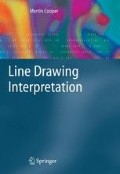Although a line drawing usually represents a whole family of three-dimensional objects, human beings manage to communicate using this highly ambiguous medium. We postulate that communication is possible due to the universality of criteria used to determine the most likely interpretation. In this chapter, we study in particular the preference for cubic corners in interpretations of line drawings of polyhedra.
Access this chapter
Tax calculation will be finalised at checkout
Purchases are for personal use only
Preview
Unable to display preview. Download preview PDF.
Rights and permissions
Copyright information
© 2008 Springer-Verlag London Limited
About this chapter
Cite this chapter
(2008). Discrete In°ation Using Cubic Corners. In: Line Drawing Interpretation. Springer, London. https://doi.org/10.1007/978-1-84800-229-6_4
Download citation
DOI: https://doi.org/10.1007/978-1-84800-229-6_4
Publisher Name: Springer, London
Print ISBN: 978-1-84800-228-9
Online ISBN: 978-1-84800-229-6
eBook Packages: Computer ScienceComputer Science (R0)

